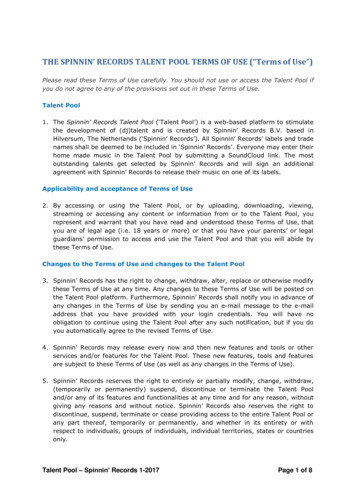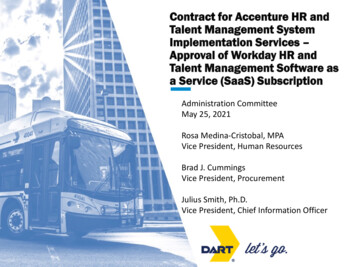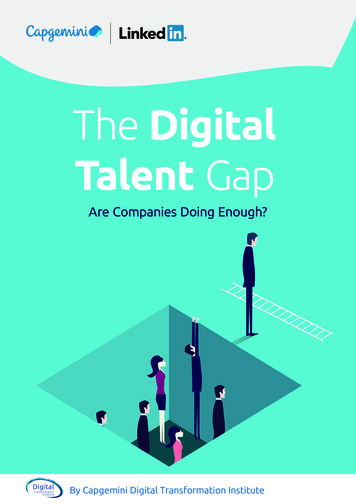
Transcription
FUTURE OF WORKTHETALENTSHIFTLEADERS’PERSPECTIVE:GERMANY
IntroductionGermany, welcome to the Global Talent Crunch. The world is teetering on thebrink of an impending skilled labor shortage, set to hit developed and developingeconomies alike. For Germany, it’s a challenge of epic proportions, and one that couldconstrain the country’s economic growth by 14.4% at 20301. Globally, at 2030, KornFerry research forecasts talent shortages of 85.2 million skilled workers, resulting inUS 8.452 trillion in unrealized revenue across twenty of the world’s major economies2.As early as 2020, the skilled worker deficit could hit 20.3 million people.C-suites worldwide are conscious of the challenge posed by the talent crunch: 84%of corporate leaders told us that to survive in the future of work, their company willneed more highly skilled workers as a proportion of their workforce3. Yet the truemagnitude of the problem remains opaque. Although many reported that talentshortages were starting to impact their business now, they told us they see thesechallenges as cyclical rather than chronic: while 66% of executives predict a highlyskilled talent shortage by 2020, only 52% believe there will still be a deficit at 2030, letalone endemic global shortages.How could the talent crunch disrupt the plans of organizations worldwide? How canbusiness mitigate this new challenge to their strategies? And, at the local level, whataction should leaders take that will allow them to succeed despite an increasinglytalent-constrained environment?In this supplementary report, Korn Ferry examines leaders’ attitudes to talent, risk,and value creation in the future of work, to discover how well-prepared leaders are tomitigate the impact of the talent crunch in Germany.Korn Ferry (2018) The Global Talent Crunch: Country Perspective, GermanyKorn Ferry (2018) The Global Talent Crunch3Korn Ferry (2018) The Talent Shift122
3
The Financial ImperativeGermany is already experiencing a talent crunch—it is predictedto face a deficit of 1.2 million skilled workers at 2020, a figurewhich will balloon to 2.5 million by 2030. Significantly, over 25% ofthis deficit will occur in Germany’s financial services sector4.For Germany, the unrealized revenue due to talent shortagescould reach US 166.73 billion by 2020, climbing to US 629.89billion by 2030. In terms of GDP, US 629.89 billion represents14.4% of Germany’s economy5 at 2030.Exacerbating this constrained economic growth, Germanorganizations could find themselves subject to an average paypremium of US 16,000 per highly skilled worker at 20306. Thepay premium refers to the amount extra an organization will haveto pay (on top of inflation) to attract and retain scarce talent in anemployees’ market.To give an idea of the scale of this cost in the future of work, thetotal additional cost for highly skilled talent in Germany at 2030will be an extra US 175.63 billion7.Leaders are already clear that reduced talent supply may escalatetheir bottom-line costs. Forty-two per cent of leaders in Germanysaid that talent shortages may force them to increase salariesunsustainably.Korn Ferry (2018) The Global Talent Crunch: Country Perspective, Germany.Korn Ferry (2018), The Global Talent Crunch: Country Perspective, Germany.6Korn Ferry (2018), The Salary Surge.7Korn Ferry (2018), The Salary Surge.454
Talent blind spots may derailleaders’ plansLeaders in Germany have ambitious plans to grow theirrevenue in the near and long term: 88% of leaders said theyplan to grow an average of 21% by 2020 increasing to 32%by 2030.They have similarly aggressive plans to grow headcountover the same time period: 72% of organizations intend toincrease headcount by 23% at 2020 to 34% by 2030.However, a large proportion of Germany’s C-suite believetheir organizations are safe from the talent crunch: 46%believe there will either be enough or even surplus skilledtalent in the German labor market at 2030.This attitude appears to reflect leaders’ belief thattechnology will come to dominate the workplace, at theexpense of skilled talent—77% said they think technology willsurpass people as their greatest value creator between 2018and 2030. Further, 63% of companies ranked technologyas a top priority when developing and executing theircompany’s business strategy. But the majority of leaders inGermany do not see the future as a simple battle of manversus machine: 85% also said their companies will needmore highly skilled workers as a proportion of the futureworkforce, with 83% agreeing that technology itself willcreate the need for more highly skilled jobs.Historically, ever-more sophisticated technology hascreated more demand for highly skilled workers than it hasconsumed. This trend is likely to continue. Companies needworkers with creativity, emotional intelligence, diplomacy,and negotiation skills to navigate the new world of work.Alan Guarino, Vice Chairman, CEO and Board Services,Korn Ferry5
A workforce fit for the futureLooking at skilled talent more granularly, Germanorganizations are predicting that digital skills will behighly relevant to their success. The top five rolesGermany’s leaders view as critical are: Big data analytics Information security Digital transformation Digital analytics Digital product developmentTo deliver their strategies, a very high 88% ofleaders in Germany have a formal forecast fortheir skilled talent needs—yet only 3% have plansthat extend through to 2030. Although they areanticipating which roles will be most impactful inthe future of work, 64% say they find it easier tocreate action plans around technology and othertangible assets, citing pressure from shareholdersfor quick returns and short leadership tenures aslimiting factors.Globally, 51% of leaders say they haven't faced asignificant talent shortage before, meaning there islikely a dearth of leaders with practical knowledgeof how to deal with a crisis in this area. Germany’sC-suite say they would mitigate talent shortagesby: investing in their employer value propositionto attract and retain skilled talent; implementingmass retraining throughout their workforce;paying a salary premium to attract skilled talent;reconsidering where they focus their organization’sgrowth strategy, investment, and geographicfootprint; and, increasing prices to mitigateincreased labor costs.6
Can Germany find the talent itneeds overseas?Top executives are already sourcedinternationally, especially by “tiger economies”such as Singapore and Hong Kong. As skilledtalent will soon be in short supply globally,companies are likely to consider casting the netfarther afield at the professional level.But worldwide, many organizations havemisplaced confidence that they can find skilledworkers in other countries: 86% of businessleaders say their response to a skilled talentshortage will be to increase their strategic focusand expand in markets with a more plentifulsupply of skilled labor. However, according tothe data from The Global Talent Crunch, India isthe only country predicted to have a surplus ofhighly skilled workers at 20308, and companiesoverseas will be fighting hard to retain the talentthey do have. Even with advances in technologyenabling people to work together acrossborders, planning to import talent or set upnew operations where the talent supply is moreplentiful will not be a feasible option.8Korn Ferry (2018) The Global Talent Crunch7
Cracking the talent crunchThere is an opportunity for forward-thinking leadersto steal a march on their competitors by securingthe highly-skilled talent they already have andassessing and upskilling their mid-skilled talent tostep into more complex roles.Leaders that prioritize building a highly-skilledtalent pipeline will shield their organizations fromthe worst effects of the talent crunch, which includeconstrained growth, paying a premium for missioncritical talent, and fighting with competitors in thesame shallow pool. On an employer level, leadersshould focus on what makes their organizationuniquely attractive to employees, both in terms ofthe company’s core purpose, and all the rewardsthey can offer people—not just monetary.With so little certainty in the future of work, butso much pressure to deliver short-term returns,it’s understandable that many organizationsintend to forge ahead without rock solid plans formitigating the talent risk—but their competitors andshareholders are unlikely to be so forgiving. Whilethe rapidly shifting business environment meansmarkets are difficult to predict, leaders can positiontheir organizations for success through proactivelytackling the common challenges that we know willexist—the need to reskill lower ranking employeesand improve their organizational agility. Being alertand responsive to market changes as they arise andaggressive scenario planning are not just sensiblebut necessary steps for businesses to survive inthe future of work. This agility should prioritize theretraining and redeployment of vast swaths of theworkforce, both now and perpetually as marketsevolve, so companies not only can avoid masslayoffs as lower-skilled tasks become automatedbut also so they create their own highly skilledtalent pipelines. Companies that fail to forecast,develop, and evolve their talent managementstrategies will stumble into the future of work blindto its realities, and without the time to make up lostground. The time for a major rethink of the talentpipeline is now.8
In most organizations in Germanythe reality of digital transformationleads to a huge surplus of talentin some areas—typically thosethat can be augmented by digitaltechnology—and a dearth oftalent in others—typically thoseroles that leverage, innovate andcreate with digital technology.The major challenge for leadersis identifying where the futureand surpluses and gaps are andfinding the best strategy todeal with both. With the furthercomplication of the talent crunch,strategic options should not belimited to only recruitment andrestructuring; organizations shouldprioritize people development,relocation programs, anddeveloping a compelling employervalue proposition. Unfortunately,the talent crunch is often seenonly as a risk with limited, oftentraditional, options to mitigate it.But seeing the talent crunch asone driver that can help clarifypriorities in their overall workforcestrategy will help leaders navigatedifferent workforce trends andensure their pipeline of talent isrobust for the future.To find out more about the talent crunch and howto mitigate it in Germany, contact Christian Weiss,Senior Principal, Korn Ferry Germany.Email: christian.weiss@kornferry.comCall: 49 69 505055 222References1.Korn Ferry (2018) The Global Talent rn Ferry (2018) The Salary -surge/3.Korn Ferry (2018) The Global Talent Crunch: CountryPerspective – reports/4.Korn Ferry (2018) The Global Talent Crunch: CountryPerspective – reports/5.Korn Ferry (2018), The Salary -surge/6.Korn Ferry (2018), The Salary -surge/7.Korn Ferry (2018), The Salary -surge/8.Korn Ferry (2018) The Global Talent stian Weiss, Senior Principal,Korn FerryMethodologyThese findings are based on a survey of 1,550business leaders (c-level and c-level minus one)in multimillion-dollar organizations and from 19countries across the following regions: Americas,EMEA, and Asia Pacific.To get the global perspective and find out moreabout how this research was conducted, pleasetake a look at the full report methodology.9
About Korn FerryKorn Ferry is a global organizational consulting firm. We help clientssynchronize strategy and talent to drive superior performance. We work withorganizations to design their structures, roles, and responsibilities. We helpthem hire the right people to bring their strategy to life. And we advise themon how to reward, develop, and motivate their people.
to face a deficit of 1.2 million skilled workers at 2020, a figure which will balloon to 2.5 million by 2030. Significantly, over 25% of this deficit will occur in Germany’s financial services sector4. For Germany, the unrealized revenue due to talent shortages could reach US 166.7











